The 16-arch Westfield viaduct that straddles the River Avon on the West Lothian and Falkirk border has returned to its former glory following a £2m renovation programme funded by National Highways’ Historical Railways Estate (HRE).
HRE comprises a collection of more than 3,100 structures and assets that were once part of Britain’s rail network. Since 2013, National Highways’ HRE team has had the responsibility for looking after the structures and carrying out repairs on behalf of the Department for Transport (DfT).
Work on the Westfield Viaduct, led by main contractor Balfour Beatty, included masonry repairs, waterproofing and the installation of 19 bat bricks, six bat tubes and two bat boxes. It took 18 months to complete and should see the structure, built in the 1850s, stand proudly for a few generations more.
HRE civil engineer Colin McNicol said he was pleased with how well the work had gone. “The viaduct had numerous issues that needed attention to ensure it remained safe and in good order. The work that has been completed makes any future plans to reopen the viaduct as an active travel route for pedestrian, cyclist and other users a real possibility,” he says.
Nichol says that the repair work unearthed nothing especially surprising: “It’s an old structure that hasn’t had a great deal of intervention over the years and what maintenance it has had has been on a piecemeal basis.
“The main issue was water ingress through the track ballast but also wind-blow into the sides of the structure. It’s probably not our most exposed structure in Scotland but it can be bitterly cold up there, even on a good day. Having said that, it is a glorious location,” adds Nichol.
Westfield Viaduct is indeed one of the grander historic railway structures maintained by National Highways Historical Railways Estate (HRE). Even though National Highways has no remit for highways in Scotland – that is a devolved government matter – it still looks after railway viaducts there that are no longer in use.
Westfield Viaduct was constructed between 1854 and 1855 as an extension of the Monkland Railway. This branch line ran from Blackston Junction on the Slamannan Railway to Bathgate to meet the Wilstontown, Morningside and Coltness Railway before turning west towards mines around Crofthead. It became part of the North British Railway in 1865.
The structure has 12 large arches of about 14.5m span and two small ones at either end. In total it stretches for 201m over land and water and stands 18m from the top of the arch to the riverbed below.
Before renovations could begin two bat surveys were carried out at different times of the year, with a summer re-entry survey to ensure bats had not returned to work areas for hibernation.
Surveys involved abseilers, under the direction of bat-licenced ecologists, checking crevices in the masonry with endoscopes for signs of bat activity. Drones were used for further checks.
Any crevice that showed signs of bat droppings or tell-tale dark stains on the stones, and crevices that were too difficult to survey properly, were fitted with excluders that allowed bats to leave but not to re-enter. All the surveys were completed under a NatureScot bat licence.
Temporary bat boxes, tubes and bricks were installed on areas of the structure where work was not taking place for bats to use safely during the hibernation season. Multiple bat bricks, boxes and tubes were then built into the viaduct as permanent bat roosts.
Though the bat-protection works might seem excessively thorough, they are required by law and are nothing out of the ordinary for the HRE team: “Most of our structures have bat issues,” says Nichol.
Other work included extensive vegetation clearance and repairs to all 16 spans, along with north and south parapet repairs and waterproofing work. New cast iron pattress plates, manufactured to match the originals, have also been installed to replace damaged elements and stone repairs were colour-matched to the original unweathered material.
“The deterioration was variable throughout the structure,” says Nichol. “Stone is not a completely homogenous material and the damage was therefore worse in some spans than in others. At some point the original iron handrails were removed, which left holes in the coping stones to collect water. That simply accelerated the damage.
“We used a reasonable amount of new stone, particularly to the face and soffit of Span 9, which was in the worst condition. We don’t know exactly where the original stone was quarried, but it was locally sourced and there are still local suppliers. We dressed the existing stone back to sound material so we could see the original colour and it was quite easy to match the new stone.”
There was also a lot of repointing required to the old brickwork, and many spalled bricks were replaced.
Concrete haunches running either side of the old track bed were broken out and removed. “We assume they were cast at the same time the pattress plates were fitted as part of a wider strengthening operation,” says Nichol. But the reason for the pattress plates is also something of a mystery, he says:
“Usually, pattress plates would be fitted if there was bulging or some other sign of movement in the spandrel walls. But there’s no specific evidence that there was ever any problem and there’s no record of them being fitted.
“Unfortunately we don’t have the original drawings, but it’s safe to assume that the pattress plates were a later addition,” he adds.
The pattress plates were nevertheless left in place and new ones fitted to replace those that were damaged (see box, p29). The concrete haunches were removed, however.
Water ingress and freeze-thawing are the primary threats to the viaduct’s structure and so waterproofing was a top priority for the restoration team. To do this, the concrete haunches were broken out and removed along with the track ballast. Waterproof membrane was then loose-laid over the track bed and new ballast laid on top.
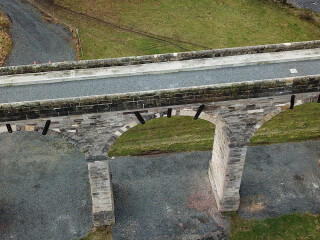
“Originally, there might have been a layer of clay, or maybe a bituminous material on the track bed to keep the water out,” says Nichol, “but what we’ve done is much better and will last a lot longer.”
National Highways’ HRE team is usually under fire in the media for taking somewhat cackhanded shortcuts in its Victorian bridge maintenance work. Over the past couple of years, several stone bridges deemed unstable or too expensive to restore were simply back-filled with rubble or concrete beneath the arches, thus preventing any development of greenway routes along the disused railway alignments beneath them.
In June last year, the former chairman and chief executive of the Strategic Rail Authority, Richard Bowker, was so incensed by what had happened to Great Musgrave Bridge in Cumbria’s Eden Valley, that he said: “I’ve never been big on ‘and now heads must roll’ but, on this occasion at least, the CEO of National Highways must formally apologise as well as scrap this policy of unwarranted vandalism.”
National Highways has defended itself against criticism of its bridge infilling. A spokesperson said: “National Highways has been responsible for looking after more than 3,100 structures and assets in the Historical Railway Estate, owned by the Department of Transport, since 2013. The vast majority of our work involves repairs, other strengthening works and restoration schemes, which we have carried out on hundreds of structures. By comparison, we have completed infill work on 52 structures, all to make them stronger and safer for the public to use.”
The HRE Group, an alliance of engineers, sustainable transport advocates and greenway developers, has been orchestrating the campaign against the bridge infilling. However, on this occasion it was, for once, full of praise.
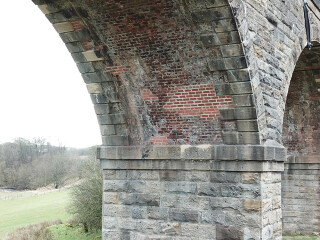
HRE Group spokesperson Graeme Bickerdike said: “The Avon Viaduct near Westfield is one of the most striking structures of the nation’s Historical Railways Estate. Decades of neglect had left much of its stonework in a degraded condition, whilst vegetation growth and unsightly brick repairs added to the sense of dilapidation. This significant investment in the viaduct’s refurbishment is great news and we welcome the sympathetic nature of the work that’s been undertaken by National Highways’ contractors.
“Let’s hope that proposals come forward to repurpose the structure for community benefit, acknowledging its status as an infrastructure asset and outstanding heritage feature.”
Colin Nichols hopes so too, but warns there are still obstacles to overcome. “The viaduct has been closed off since the early 2000s and in the meantime the land at either end of the viaduct has been sold to private owners,” he explains.

The viaduct spans the river marking the boundary between two local authorities, West Lothian and Falkirk, and is a significant crossing point over the river Avon.
“There have been talks involving [sustainable transport organisation] Sustrans and the two local authorities but there is still no safe handrail so you can’t let the public onto the viaduct until there is. But it’s still landlocked at either end and although there’s a public footpath to one end of the viaduct, there’s no access to it.”
While deliberations continue over the possible future use of the viaduct, HRE will continue to monitor and maintain the structure. “We carry out visual inspection of all our structure annually and we do a detailed fingertip inspection every six years where we go over every inch of the structure, often using rope access,” says Nichol.
Nichol’s patch covers all of Scotland, Northumberland and Cumbria. “I’ve currently got several structures scheduled for repair,” he says. “They’re not all 16-span viaducts – most are far more modest – but I’m very lucky to be able to work on these wonderful structures and I’m very proud of what we’ve achieved on this one.”
Replacing the pattress plates
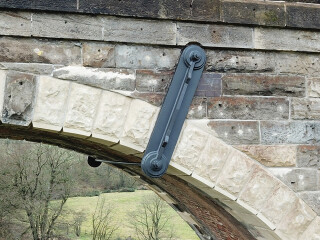
Millar Callaghan Engineering Services was awarded the contract to replace the damaged and broken pattress plates and tie rods that bind the structure together at the top of the 16 arches.
A detailed survey ascertained detailed dimension and design of the existing cast iron plates so that the new replacement plates would exactly match. The new plates and tie rods were fabricated in Millar Callaghan’s Irvine workshop.
A spider crane was positioned on top of the viaduct to assist with the removal of the old, and installation of the new, pattress plates. Powered access platforms were used to access both the outside face and the underside of the arch to remove and install steelwork.
The old cracked and damaged plates were removed with care and skill to ensure that they did not break apart during removal. The new plates and tie rods were then installed and torqued up into position. A fresh coat of paint was applied to freshen up both the new and existing ironwork.
Another footbridge – and another viaduct
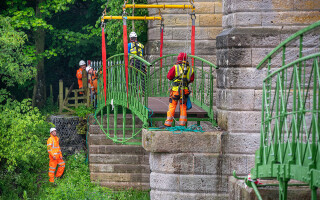
In July 2022, National Highways Historical Railways Estate (HRE) reinstalled a rare Victorian footbridge alongside the Roxburgh Viaduct which spans the river Teviot southwest of Kelso.
The wrought iron footbridge, which opened in 1850, is a key part of a popular circular walking route along the Border Abbeys Pedestrian Way.
Towards the end of 2020 the bridge was dismantled and the 500 pieces were transported to specialist contractor AmcoGiffen’s Barnsley workshop for repair and refurbishment.
“The footbridge had been badly impacted by flooding as well as general decay and without these major repairs and renovations it would have become unsafe to use,” says HRE director Rich Marshall.
Working closely with Scottish Borders Council conservation officers, AmcoGiffen’s engineers assessed each piece of the footbridge, refurbishing and reusing as many as possible.
Elements that were beyond repair were digitally scanned so exact copies could be produced using a variety of techniques including laser cutting, profiling, casting and welding.
Dome-headed bolts have been used to replicate the appearance of the rivets used on the original bridge construction.
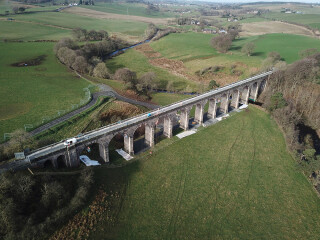
Each of the footbridge’s three spans were then reconstructed, using a combination of retained and newly fabricated elements, and painted ready for the journey back to the Scottish Borders.
Special steerable trailers were used to carry the 16m-long spans along narrow roads and the old track bed on the approach to the viaduct.
A 55-tonne-capacity crane and rope access specialists worked together to manoeuvre the bridge back into position. Onsite fabrication work was needed to link the three spans back together before the bridge could be reopened to the public.
“This wasn’t a quick or easy renovation project, but it was very worthwhile and we’re incredibly proud of what has been achieved,” says Marshall.
HRE takes ‘lost’ footbridge under its wing
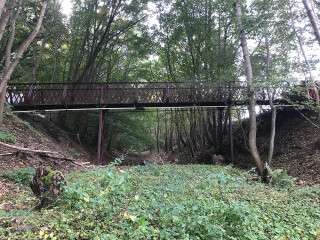
Following completion of the Westfield Viaduct restoration, HRE engineer Colin Nichol turned his attention to the refurbishment of the Boleside Road bridge, a ‘lost’ footbridge near Galashiels in the Scottish Borders.
The footbridge dates back to the early 20th century and carried a footpath across the former Selkirk Branch line until its closure in 2021.
The path gave the public a chance to enjoy popular riverside walks, something that took on new significance for people exercising during the Covid-19 pandemic.
Although the Boleside Road bridge was on a popular walking route from Galashiels down to the River Tweed, the local authority was obliged to close it in 2021 amid concerns about its structural integrity.
At the same time, council officials began research to establish the actual ownership of the bridge. The search concluded with National Highways agreeing to add the bridge to the portfolio of more than 3,100 historic structures that it maintains on behalf of the Department for Transport.
A three-month programme of works, valued at £356,000, is now under way to restore the bridge and allow the footpath over it to reopen to pedestrians.
“It’s quite unusual to discover a structure like this that isn’t already part of the HRE so we’re delighted to be undertaking work which will extend its life for many years to come,” said Nichol.
“This hasn’t been a simple project to organise as we’ve had to pay for a mains gas line to be relocated before we could begin repairs but given the significance of the bridge, which is much cherished and one of the few surviving structural elements from the railway network in Galashiels, it is more than worth it.”
To prevent the bridge’s condition deteriorating further the heavily-corroded steel floor plates are being removed and replaced, along with parts of the horizontal supporting sections that have also deteriorated.
Several of the lattice bars, also heavily-corroded, are being replaced with new steel, fixed to the existing structure using tension control bolts with domed heads that look similar to the original rivets.
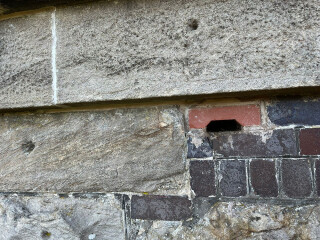
Got a story? Email news@theconstructionindex.co.uk



